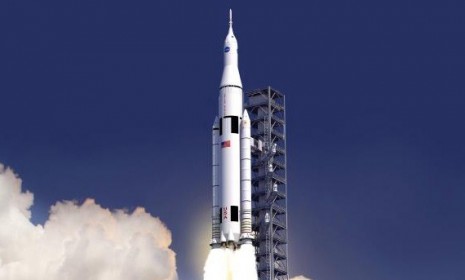NASA's new 'monster' rocket: Gamechanger or boondoggle?
A powerful new "megarocket" will cost billions, and will take NASA, well... no one knows where

NASA has announced plans to construct the largest rocket ever built, powerful enough to take people and cargo to Mars and beyond. The announcement follows months of political wrangling in Congress, the White House, and NASA headquarters over the direction the space agency should take in the post-shuttle era. Though this project, "blandly named the Space Launch System," or SLS, has some potential for reinvigorating America's space program, NASA has set no specific timetable or destination for SLS. Here, a brief guide:
What's different about the SLS?
In a word, thrust. The SLS is a "megarocket" that will be able to lift 70 metric tons into orbit; "the largest unmanned rockets currently available can lift about one-third that much," says Kenneth Chang in The New York Times. Future versions of the SLS are expected to lift a whopping 130 metric tons, more than even the Saturn V rockets that powered the Apollo moon missions. The SLS also uses an "enhanced space shuttle fuel tank, which holds liquid hydrogen and liquid oxygen for the ship's engines," says Irene Klotz at Discovery News.
The Week
Escape your echo chamber. Get the facts behind the news, plus analysis from multiple perspectives.

Sign up for The Week's Free Newsletters
From our morning news briefing to a weekly Good News Newsletter, get the best of The Week delivered directly to your inbox.
From our morning news briefing to a weekly Good News Newsletter, get the best of The Week delivered directly to your inbox.
What is the SLS for?
Nobody is quite sure. The rocket system is an engine for powering missions to destinations that are currently undetermined. It could go to Mars, or the moon, or other celestial bodies, but in the current political environment, grandiose projects are hard to fund. "We are in an era in which we have to do more with less, and the competition for available dollars will be fierce," says Florida Democrat Sen. Bill Nelson, a former shuttle astronaut, as quoted by Britain's Guardian.
How much will this cost?
About $3 billion a year for the next six years, though no NASA official has yet delivered any longterm cost projections. Space agency critics who have analyzed leaked NASA documents, however, say longterm costs could reach $62.5 billion by 2025.
A free daily email with the biggest news stories of the day – and the best features from TheWeek.com
How did this new rocket get approved?
NASA's facilities are in Sen. Nelson's home state of Florida, and NASA mission control is located in Republican Sen. Kay Bailey Hutchinson's Texas. Both senators are in high-ranking positions on congressional committees and subcommittees that help fund NASA programs; some wags have sarcastically referred to SLS as the "Senate Launch System."
Sources: Discovery News, Guardian, NY Times
-
 Will Trump’s $12 billion bailout solve the farm crisis?
Will Trump’s $12 billion bailout solve the farm crisis?Today’s Big Question Agriculture sector says it wants trade, not aid
-
 ‘City leaders must recognize its residents as part of its lifeblood’
‘City leaders must recognize its residents as part of its lifeblood’Instant Opinion Opinion, comment and editorials of the day
-
 10 upcoming albums to stream during the winter chill
10 upcoming albums to stream during the winter chillThe Week Recommends As the calendar turns to 2026, check out some new music from your favorite artists